- Home
- Injections
- Laser Treatments
- Specialties
Specialtiesview all
- Other Treatments
- Before After Photos
Before After Photosview all
- Contact Us
- Doctor And Staff
- About Celibre
- Blogs
If you suffer with acne then you know personally the constant struggle to keep your skin looking and feeling as normal as possible while fighting breakouts. We want to discuss the important topic of skin care and acne because we see so many acne patients who really are misinformed. In many cases, this causes their acne to get worse rather than better. In a nutshell, you need to be kind to your acne-prone skin. Yes, we understand you want to blast it with the toughest, oil-busting products you can find, but understand that this might be part of your problem!
How? Because many people misunderstand what acne really is. It is an inflammatory skin condition (in most cases). Yes, your skin is oily, but it is also inflamed when broken out with acne. So, using harsh, astringents (alcohol) or abrasive products is going to inflame it more and can trigger more breakouts.
The skin is the largest one we have and the only one that has constant contact with the environment around us. To protect itself, the outer layer, known as the “acid mantle”, is super important because it tries to maintain a certain pH (low or acidic) to fend off bacteria, fungi and yeasts. Our oil glands are part of this process. When we use drying or harsh products, we disrupt the pH of our skin. Our body takes note and tells our oil glands to pick up the pace to help rebalance it. We then make more oil and a vicious cycle begins.
What is the answer then? Gentle skin care products that maintain the skin’s pH. If your skin is healthy and functioning properly, then you are in the best position to win against acne. If you’re fighting your skin’s pH and causing it to function poorly, then you’re helping the acne take over and becoming your own worst enemy!
Start with a gentle face cleanser. Consider green tea products as they are full of anti-oxidants and may help with the inflammation. If your skin is dry, then you need to moisturize. Choose oil-free products and use them regularly. This will help calm your skin, restore the pH balance and help it feel and look better.
If your skin is sensitive and always dry and you can’t tolerate Retin A, retinoid products or benzoyl peroxides, consider using a glycolic acid product. These are right in line with the skin’s pH and many products are formulated for dry skin. These are gentle exfoliants that over time, work well without overly drying or irritating the skin.
Don’t be part of your acne problem. Listen to your skin! If it’s tight, red, dry, flaky and painful, then it’s time to make some changes. It can take a few weeks to see improvement so hang in there!
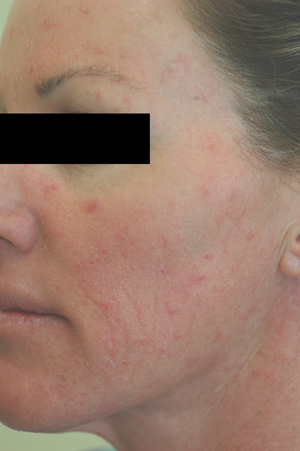
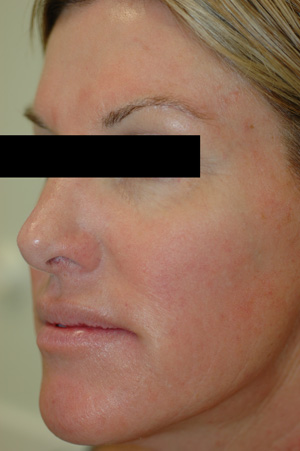
If you’ve never heard of Peutz Jeghers Syndrome Lips, it’s because it is relatively uncommon. It is estimated to affect one out of every 25,000 to 300,000 individuals. It is a genetic disorder that can be passed on by an affected parent, but it may also occur spontaneously as well.
If you have Peutz-Jeghers Syndrome, there’s a good chance that you have also developed a well-known, tell-tale sign of the condition: multiple, brown spots on your lips.
While these spots can also come up inside your mouth and on other areas of your face and body as well, we understand the unwanted and unwelcomed attention that brown spots on your lips can bring. At Celibre Medical, we’ve helped many patients just like you get rid of or significantly fade these aggravating spots by using our q-switched laser technology.
Q-switched lasers target the excess pigmentation, or melanin, in the spots. The treatments are safe, effective and relatively quick and painless. Many of our patients see impressive results after just 1 to 3 treatment sessions typically spread a month apart. Take a look at the before and after photos of one of our patients below.

If you have Peutz-Jeghers and want to do something about dark spots on your lips, we can help you. Please give us a call to learn more today.
The common wart has plagued mankind for centuries. Even today it remains a bit of a mystery as to why some people struggle with warts and others don’t. Despite the widespread affliction of warts (over 2.6 million people in the U.S.), we still don’t have full proof treatments or a cure.
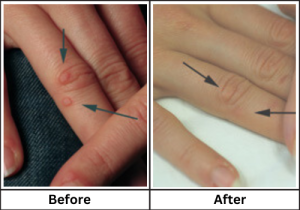
Verrucae is the medical term for warts. If you have or have had them, you know what a pain they can be. They most commonly affect the hands and feet, but any body part with skin can develop a wart. HPV or human papilloma virus causes them, and there are hundreds of different strains of HPV. One less commonly affected area that doctors often misdiagnose is the face. Facial warts can affect younger people. They erupt suddenly and look like pimples—just a few millimeters in diameter and pink to flesh colored. People can group them together or notice them appearing in a linear (in a line) fashion; others might observe them scattered in various areas of the face. Since they’re viral, they don’t get better with acne medications or treatments.
No matter where warts appear, most people with them want them gone fast. It seems like it should be an easy task, but warts can be remarkably stubborn and resistant to treatment. They are frustrating to both patients and practitioners! Some of the more popular wart treatments include freezing (cryotherapy) and irritation with things like salicylic acid solutions. Many people want to surgically remove them, but “cutting out” infection doesn’t always mean it will go away, and despite the availability and popularity of “natural” and “alternative” treatments for warts, there isn’t much evidence to show that any of these really work at all or are even safe to use.
An alternative to traditional treatments is class IV medical lasers. Two specific lasers we use are the pulsed dye and q-switched, most often in combination. You are probably wondering how a laser can treat a viral infection. It’s a great question and one that has a pretty cool answer! Lasers work for viral warts by destroying the blood vessels in the infected skin and generating sufficient heat to interfere with viral replication. If there’s no blood supply, the skin is basically uninhabitable for the wart and virus can no longer continue to grow. This treatment is totally different for this reason, because it is a very specific and predictable way to get rid of warts (unlike painful freezing or other topical methods where it’s more hit or miss).
If you’re thinking that laser treatment is painful, it really isn’t! Treatment is fast—usually only a few minutes to complete. We can safely use our lasers to treat warts on any skin type (color), and although there is no magic number of treatments that guarantees complete removal, we typically eliminate most warts with 1-3 treatments.
You’re probably wondering why more offices don’t offer laser treatment of warts? The reason is that lasers are expensive, and if a practice can’t (or doesn’t know how to) use them for anything else, it’s not cost effective to have one. They also require extensive knowledge of laser medicine to operate and use safely and effectively. This type of training and experience isn’t practical for many of the different medical specialties that see patients with warts.
Here at Celibre Medical, we are experts at using lasers for everything they can be used for—even warts. We’ve seen the dramatic improvement that patients can have despite failing many other types of treatments. If you’re frustrated by the slow (or lack of) progress with your current wart therapy, consider lasers—just make sure your treating practitioner has plenty of expertise in their use.
Do you have Rosacea? Redness, irritation, flaking and pimples well past your mid-twenties? While you may know about the facial redness that goes along with Rosacea, maybe you weren’t aware that these other symptoms can be caused by it too? While treatments can certainly keep Rosacea under control, unfortunately it can be chronic and has no known cure. Read on to learn more and find out how pulsed dye lasers can help you.
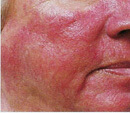
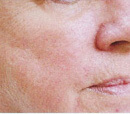 Rosacea involves chronic skin inflammation. This inflammation over time stimulates the small blood vessels in your cheeks, nose and chin to become enlarged. These blood vessels, called telangectasias (small capillaries), are what causes the redness of your rosacea. These small blood vessels can often be accompanied by burning, flaking and pimple like eruptions. If this process goes unchecked for a long time, the chronic irritation can cause permanent changes in skin texture. This can also change the appearance of our nose, making it look larger, bulbous, and swollen. This is called rhinophyma.
Rosacea involves chronic skin inflammation. This inflammation over time stimulates the small blood vessels in your cheeks, nose and chin to become enlarged. These blood vessels, called telangectasias (small capillaries), are what causes the redness of your rosacea. These small blood vessels can often be accompanied by burning, flaking and pimple like eruptions. If this process goes unchecked for a long time, the chronic irritation can cause permanent changes in skin texture. This can also change the appearance of our nose, making it look larger, bulbous, and swollen. This is called rhinophyma.
Why people get Rosacea is still a mystery. We believe that there are several factors at play: genetics, environmental exposure, stress and an imbalance of otherwise normal bacteria living on your skin. While you can’t change your genes, you can control some of the Rosacea triggers. Proper skincare products, sun protection and avoidance of foods (spicy, etc.) and beverages (alcohol, hot drinks, etc.) that trigger flare ups can help keep it under better control.
At Celibre Medical, we help you understand your Rosacea better. In addition to helping you understand those triggers that cause Rosacea flares, we use FDA-approved pulsed dye lasers to diminish the appearance of redness and small blood vessels. This not only helps with your appearance but can slow down the development of the condition.
No, we can’t cure Rosacea. But with proper care, we can help you can gain control over it. Contact us today to learn more about controlling your Rosacea.
Acne is a frustrating condition that affects almost everyone. Usually, we think about acne as a temporary problem during our teenage years, but there are many adults who continue to suffer with acne in later life. While it seems that something so common should be easy to treat and get rid of, the reality is that it’s not!
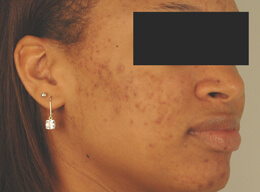
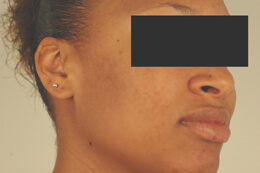 The main reason that acne is difficult to treat is that it has multiple causes. Hormones, genetics, oil production, bacteria and skin care all play a role in acne. This helps to explain why there is no perfect treatment for everyone.
The main reason that acne is difficult to treat is that it has multiple causes. Hormones, genetics, oil production, bacteria and skin care all play a role in acne. This helps to explain why there is no perfect treatment for everyone.
Several over-the-counter products offer some relief. Benzoyl peroxide, for example, kills bacteria living on the skin’s surface. Salicylic acid helps to unclog pores and gently exfoliate. But for many acne sufferers, these just aren’t enough.
Prescription medications target acne-causing bacteria. Oral antibiotics such as minocycline or Keflex work from the inside out to get rid of bacteria on the skin and control inflammation. Creams like Retin-A, Differin, or Tazorac unclog oil glands and slow oil production. Lastly, oral drugs like Accutane work by virtually shutting down oil production. While very effective, Accutane is expensive, potentially harmful during pregnancy, extremely drying, and can cause damage to your liver. Sounds like there should be something effective, but easier, right?
If you’re looking for an alternative treatment for your acne, consider Celibre Medical’s acne laser treatment program. It’s a safe, effective and long-term alternative treatment to the options mentioned above. We’ve designed a program to target the major instigators of acne: it exfoliates, shrinks your oil glands and kills acne-causing bacteria.
First, we use carefully formulated, glycolic acid skin care products to help balance your skin and gently unclog pores. Then, we may recommend our Aramis laser and/or photodynamic therapy which helps decrease oil production. Lastly, we’ll incorporate our Medlite laser, blu-light acne treatments and/or gentle, benzoyl peroxide skin care to kill acne causing bacteria on your skin.
By providing options that target these three major components of the acne equation, we have developed a program fits many patients needs. We can help you take the guesswork out of taking care of your acne and get you on the path to clearer, healthier-looking skin.
Do you notice that you look unhappy, like you’re frowning, even when you think you’re not? Do others ask if you’re upset or sad when you’re having a perfectly fine day? If you’ve noticed that the corners of your mouth seem to be turned downward, then we’re going to give you some information that will make you very happy—we can correct a mouth frown with Botox (Dysport), dermal filler injections, or using both.

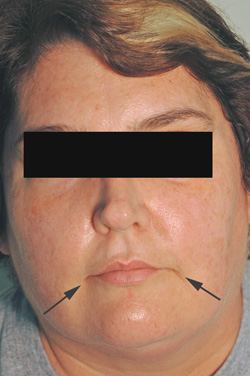 You may have a mouth frown due to an overactive muscle that pulls down the corners of the mouth. When this muscle becomes overactive, your mouth is set in a frown even when you don’t think about it. This can easily be reversed with Dysport injections into these muscles. Once relaxed, the corners of your mouth become more horizontal or straight, removing that appearance of a frown. Many people even feel they turn upwards a bit, giving you a hint of a smile.
You may have a mouth frown due to an overactive muscle that pulls down the corners of the mouth. When this muscle becomes overactive, your mouth is set in a frown even when you don’t think about it. This can easily be reversed with Dysport injections into these muscles. Once relaxed, the corners of your mouth become more horizontal or straight, removing that appearance of a frown. Many people even feel they turn upwards a bit, giving you a hint of a smile.
Another reason you can develop a mouth frown is that the corners of the mouth lose volume as you age. This subtle loss of soft tissue along with the loss of collagen and elastin in the skin can cause the edges of your mouth to turn downward because they have less structural support. This is where dermal filler injections with products like Restylane and Radiesse come in. They replenish lost volume and support the corners of your mouth, turning them in a direction that makes you look and feel happy!
Many patients like you do very well with a combination of both Botox and dermal filler injections for the mouth frown. It’s a problem that is more common than you think, but these treatments provide both safe and effective correction that will get you smiling again in no time at all!
In aesthetic medicine, it’s easy to get caught up in the hype surrounding a new device or product. The “latest-and-greatest” bursts onto the scene in a blitz of well-funded, flashy, eye-catching marketing. As the buzz grows, patients catch onto the craze and start asking about a certain laser, procedure, or product almost on cue.
Many businesses often wonder if they don’t have a particular device or offer a specific service will it hurt them or drive potential patients away to other practices? We want to share Celibre Medical’s philosophy on this with you. We strive for one, single goal: we want happy, satisfied patients who trust us and the integrity of our practice. That’s it! We don’t care about a “flash in the pan” or a “one-hit wonder”. We simply won’t sacrifice your satisfaction, results, or trust all for the sake of cashing in on the latest craze or trend.
Celibre Medical focuses on building long-term relationships with the patients we serve, and we go to great lengths to protect our integrity and reputation. This means that we carefully research and subjectively review each device we purchase and the service we offer. In the case of non-invasive skin tightening devices/procedures such as Ulthera, Titan, and Thermage, we just haven’t found the results to be consistent or significant enough across the board for us to feel confident in offering these services to our patients.
“But, the before and after photos are amazing”, you reply. Well, look at them carefully again and consider a couple of things. First, these photos rarely show continued, long-term improvement. They are usually done within the first six months after treatment. This is just one way that we believe the longevity of these procedures is misrepresented. Secondly, note the head positioning of the treated patients in the photos. Many of the “before” photos have the patients’ heads tilting down and the “afters” tilting up. This obviously changes the appearance of the neck, jowls, and jawline and leaves us questioning the true results of treatment with these devices. In short, the photos don’t impress us much when you consider them beyond the first glance.
These devices all use the marketing terms “tighten” and “lift”. We understand this really appeals to those wanting these results from a non-surgical procedure. But for many people, the degree of “tightening” and “lifting” that’s desired can only be achieved from a surgical facelift or similar procedure. We promise to never “sell” you a result that we don’t truly believe we can deliver. Often, we can help you understand how other procedures, like Sculptra and/or Radiesse injections, may be beneficial for you in achieving your goals even if you’ve never considered them before. We use our experience, expertise, and proven history of results to offer you the most beneficial, cost-effective solutions for your aesthetic needs and goals.
One last point we think is important when considering a non-invasive skin tightening procedure is to look at the long-term performance of a particular device before jumping on the bandwagon. Thermage has introduced almost 20 years ago, and while it’s still around today, it certainly is not widely used or recommended. Compare this to the Lumenis LightSheer for laser hair removal. This device was introduced 15 years ago, and it remains the most popular, most frequently used device for permanent laser hair removal. When a device delivers solid, consistent and permanent results, it becomes and remains the “gold standard” of treatment. When technology is good, it stands the test of time. Unfortunately, we’re just not there yet with non-invasive skin tightening!
So, if you’ve got money to burn and you’re willing to accept less than stellar results as a return on your investment, then buy into the hype of the latest non-invasive skin tightening treatment. We just don’t see the value in offering these types of treatments to our patients and we’re not going to be pressured or swayed by the sensational marketing and full-court press of the TV or print marketing that these companies bank on people falling for.
“How can I change my what?” you may be asking. The oral commissure is the term that cosmetic professionals use to describe the area at the corner(s) of your mouth. Yes, it’s that spot where you’ve noticed a line or crease forming under the corners of the mouth! Although it’s a small area, correcting this age-related change with dermal filler injections can make a big change in your appearance.
The oral commissures are an extension of the “laugh lines”. If you aren’t sure what this term refers to, it is the area beside the nose that extends down to the corners of the mouth. As we age, the skin in this area thins and the cheeks droop. Combined with other structural and volume-related changes in the face, a permanent line can form. Don’t worry though, you don’t have to stop having fun—laugh lines can easily be smoothed with dermal filler injections.
We can also develop creases that extend from the corners of the mouth down the sides of the chin. These are the oral commissures. Volume and structural changes in the chin along with thinning skin and repeated motion trigger their formation. Rest assured, injections of dermal fillers such as Restylane, Restylane Lyft, Radiesse or Juvederm provide natural and soft smoothing to this area.
Changing the look of your oral commissures (the laugh lines) can rejuvenate the appearance of your chin, mouth, and lips. So, go ahead and smile…you’ll look even happier after this treatment!
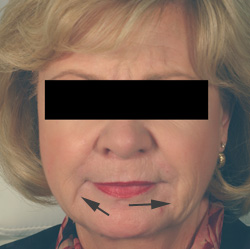
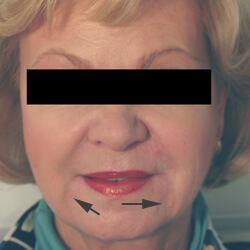
Restylane Before and After Pictures
We’ve had many requests for Voluma over the past few months in response to the launch of Allergan’s newest dermal filler product. The strategy of our organization has always been to let new products earn their place in our practice by proving, over a year or two in the market, that they are worth the hype.
And that’s what product launches are – hype. The manufacturers of lasers and injection products have to hype their products with huge PR campaigns to try and make a name for their brand in an already cluttered cosmetic dermatology marketplace. They get consumers really excited when appearing on shows like “The Doctors” and “Dr. Oz”. The problem is that the reality of the product is usually quite far off from the hype and Voluma is a perfect example.

In the FDA study used for the approval of Voluma in the cheeks, the AVERAGE patient used 6.5 CC’s of product in the cheeks. Now, if you know anything about injection product, you know it’s very unusual to use this much product. In fact, most patients at our practice get a maximum of 3-4 CC’s in the cheeks. To give you an idea of how much this would cost in today’s market, Voluma is selling for between $750 and $1000 per CC. So that 6.5 CC average patients from Allergan’s study would have paid between $4,875 and $6,500 for their injections. We don’t know many consumers willing to pay that for their injections.
On top of this fact, if you inject 6.5 CC’s of ANY dermal filler, you are going to get a lot of duration, just because there is so much product in the cheeks. Voluma claims a 2-year duration, but Juvederm XC also claimed 18 months when they originally came out and if you know Juvederm, you also know it doesn’t last for 18 months. We believe that it’s very realistic for Voluma to achieve 12 months of duration, but beyond that we are skeptical and will let consumers weight in over the next year as to whether the premium cost of Voluma is worth it.
Most of us are familiar with the saying, “You can tell a woman’s age by her hands.” This is mostly attributed to the fact that women take great measures to care for their faces but often ignore their hands. Many consumers also do not know the options that exist for hand rejuvenation.
So what makes the hands show their age? Loss of fatty tissue and collagen as we age causes the hands to reveal the bones and veins. Years of sun exposure reveal a roughened texture and brown spots (sun spots, solar lengtigines, seborrheic keratosis) become more numerous.
It is not unusual for these conditions to appear rapidly, and we often hear women say, “Why is this all happening now?” Years of bad skin care habits, genetics, and aging all catch up with us at some point. Hand rejuvenation is the process of reversing the common signs of aging hands.
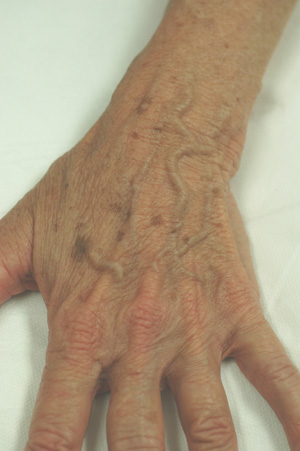
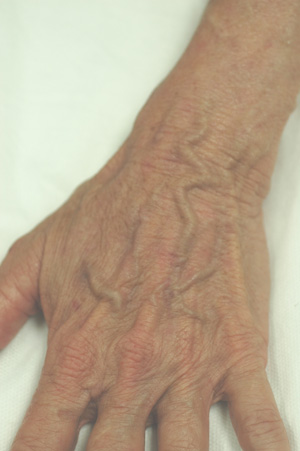
We achieve excellent results using Q-Switched laser technology to remove brown spots from the hands. These powerful lasers work by removing brown pigmentation, and at the same time, they develop heat that promotes collagen stimulation and mild skin tightening. There is no downtime, and the treatments take only a few minutes. This same laser technology also works well for face, chest, and leg spots.
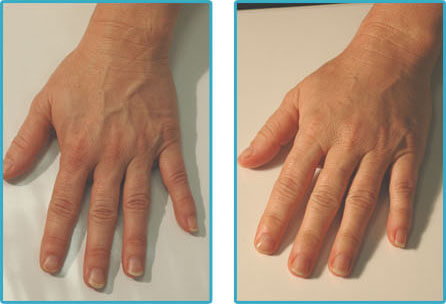
For the loss of volume in the hands, we use dermal fillers such as Restylane and Radiesse to minimize the “ropey” looked caused by thinning skin. Treating voids between veins and ligaments on the back of the hands is a job well suited for dermal fillers.
Fillers have an immediate impact, making hands look younger by creating a plump and youthful appearance. These injection benefits are immediate and continue to improve over a two-week period after injections. Results typically last for a minimum of six months.
In addition to removing brown spots and adding volume, we have one other tool in our kit for creating more youthful hands. Sclerotherapy injections with Asclera can close some of the more visible blood vessels on the back of the hand without affecting proper circulation. This procedure is used in combination with Radiesse injections to hide bulging, ropey veins.
Regardless of whether you have brown spots, visible veins, or thin, frail-looking hands, we can help rejuvenate them with lasers and injections.
In 2009, the FDA issued a “Black Box” warning for Botox that has now carried over to all neuromodulators such as Dysport and Xeomin.
A Black Box warning is the most serious warning that the FDA may issue for drugs/medications that have potentially dangerous side effects. Because of the potential spread to distant areas after injection, Botox (and its sister products) was given this warning on its packaging.
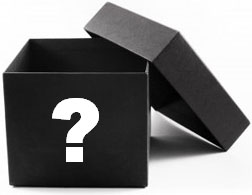 Let’s consider the following:
Let’s consider the following:
Cipro (a common antibiotic), anti-depressants, anti-coagulants, anti-diabetics
Balanced and responsible information in all things…
Our skin is our largest organ. Just like our heart, brain and digestive track, it needs certain conditions to function optimally. Skin is unique in this way because we can easily see its response to the things that we put into and on our bodies. Certain disorders such as acne, eczema and psoriasis trigger distinct and recognizable signs in our skin.
Your skin is your barrier to the outside world. And while it may look simple on the surface, it’s anything but! It is a large and complex organ that has a variety of functions. Just like everything else in our bodies, our skin has a pH. The pH is a measure of how acidic or basic something is. Without going too heavily back into high school chemistry, it’s all related to the balance of hydrogen ions. The more acidic, the lower the pH and the more basic, the higher. Neutral pH is around 7.
The outermost layer of our epidermis is called the stratum corneum. It’s a thin layer, but it has big impact on our skin’s function. The outer surface of the stratum corneum is called the acid mantle. Just like it sounds, it maintains a low pH. The acidity of this layer is the reason why it works so well as our first line of defense from environmental organisms and threats like bacteria, viruses and fungi. A major component of the acid mantle is sebum or oil. It mixes with a variety of other things in to keep a lower pH and effectively do its job.
Now back to an earlier point…what you apply to your skin, including soaps, cleansers, lotions, toners and even medications can all alter and affect the acid mantle and change its pH. So, if you have a skin disorder like acne, the things that you put on your skin play a big role in how it functions.
Many of us have been led to falsely believe that oily skin is bad. Oily skin leads to acne, causes clogged pores. Oily skin means dirty skin and on and on and on. Early on, we somewhere learn that if you have oily skin (especially oily skin with acne), you need to scrub it and use products to dry it out. Harsh soaps, astringents and scrubs are marketed to acne sufferers as the magic cure. But if you’ve been reading closely, you understand sebum/oil is an important part of normal, healthy functioning skin. So, when you remove it, especially harshly, you’re forcing your skin to make more to replace it. So, if you’re oily, you’re going to get oilier. And in most cases, your skin is not going to like this. You may see redness, dryness and flaking. This all means that your acid mantle is gone and your skin is in overdrive trying to replace it.
Remember that acne (as with eczema and psoriasis) is an inflammatory skin disorder. If you irritate something that is already inflamed, what do you think will happen. Yep—you’ve just made your acne worse and become your own worst enemy!
At Celibre Medical, we see many patients who’ve fallen into this vicious cycle of trying to dry out the skin. We don’t blame them at all! It’s advertised and practically preached to us from our teenage years that using these irritating products on our skin will help us. We work with our patients to educate them that nothing could be further from the truth! Proper, gentle skincare goes a long, long way in calming the inflammation of acne and helping it get better. Not only will this help your skin look better, it will make it feel better too.
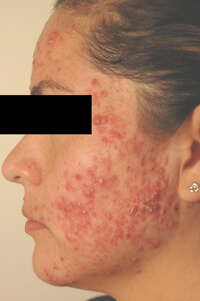
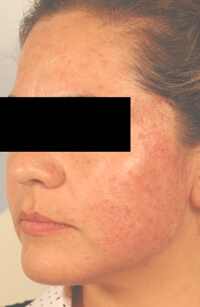
Acne Laser Removal Before and After Pictures
Do you have hemosiderin staining? Some people who suffer with it may not even realize what it is. Hemosiderin staining is an infrequent, but long-term side effect that’s usually caused by cosmetic procedures such as dermal filler injections, sclerotherapy (for leg veins) and eyelid surgery.
Hemosiderin staining is a brownish discoloration that comes about after bruising when red blood cells die. Iron is released from the red blood cells is converted into “hemosiderin” and stored in the tissue beneath the skin, causing the darkening.
Hemosiderin staining is more common with in patients who have darker skin types (colors) such as Hispanic, Asian, Middle Eastern and African American. Here, we’ve included some photos of a patient with hemosiderin staining beneath the eyes. We successfully resolved this for her by using q-switched laser treatments.
Q-switched lasers target pigment in tattoos and birthmarks, but they can also be used to target the darkening from hemosiderin staining and other types of dark, pigmented scarring. The treatments are relatively quick, easy and painless, and many patients see improvement of the dark discoloration very soon after treatment. A series of treatments may be necessary, and for most patients the pigmentation can be removed.
If you have hemosiderin staining, or a long-term, darkly colored bruise that you’d like to see go away, please consider giving us a call to have a free consultation. It may be easier than you think to get rid of the discoloration and your skin back to looking like it’s old self again.
Acne can be tough. It’s hard to find someone who hasn’t been affected, either their own personal struggles someone in their lives. For females dealing with acne, one of the options is birth control pills. Many want or need birth control, but others find help with their acne.
Oral contraceptives help some people with acne, but they can also stimulate it in others. Why? Because birth control pills are hormonal replacements for what happens naturally in your body. And there are numerous combinations of birth control pills, so just like the skin care products and medications used to treat acne, there’s no “one size fits all”.
Remember that acne begins with the oil glands. It’s the overproduction of oil that leads to clogged pores, inflammation and sometimes, deep cysts. Your oil glands are stimulated by hormonal changes in your body. This is why some experience “flares” of acne during or immediately after their menstrual cycle. The idea behind using oral contraceptives for acne is that they take over abnormal hormonal fluctuations that are triggering breakouts and make things a bit more stable. However, sometimes, changing things can trigger acne to flare. This explains why some women experience terrible acne that they’ve never had before during a pregnancy. Others become pregnant see their acne calm down as their bodies and skin take a break from the month to month fluctuations of their menstrual cycles.
The answer to the question is that sometimes birth control can help with acne. The FDA has approved three different birth control pills specifically for the treatment of acne. There are potential side effects, some of which can be serious such as blood clots. You need to discuss oral contraceptives in detail with your medical provider before you decide if they are the right choice for you.
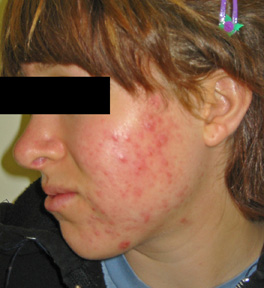
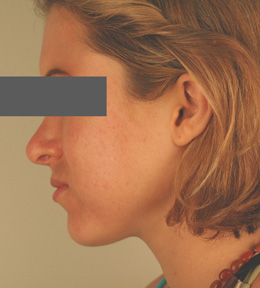
* Acne Before and After Pictures
We’ve all seen them—those infomercials for the most amazing eye cream ever. It erases every line and wrinkle and works better than surgery for your under-eye puffiness and bags!! If it were that easy, nobody would have crepey skin and puffiness around their eyes, right?! It’s tempting to want to use an eye cream to fix the crepey skin around your eyes. After all, it’s cheap and easy. Many of us see the first signs of age around their eyes. As the focal point of your face, it’s easy to understand why you’d want a quick fix.
Restylane Before and After Photos
So, why does the shape of your eyes and the skin around them start to change in your thirties and forties? Because it is the thinnest and most delicate skin pretty on your body! Think about it: this fragile, delicate skin is exposed to the sun every single day. Because UV damage thins the skin by breaking down collagen and elastin, we often start to see lines, wrinkling and drooping in our eyelids before anywhere else. When this aging happens, it will take more than a good, hydrating eye cream to save the day and make us look younger.
So, what can fix the crepey skin around your eyes. A combination of things tends to work the best. Yes, good skincare is the foundation, but you may also benefit from laser resurfacing to jump start your skin’s collagen and elastin-making capability. This procedure works the best to tighten, firm and thicken this delicate area, and it may be done without resurfacing or treating the entire face if you so choose.
Botox and Dysport injections are also helpful in reducing some of the muscle contraction around the eyes that trigger lines (frown) and creases (or crow’s feet). These injections are also used to lift and shape the brows. This doesn’t change the skin, but can make your eyes appear more open, awake and refreshed.
Lastly, injections of dermal fillers like Restylane and Juvederm can replace lost volume under the eye in the tear trough area. This helps brighten the appearance of dark circles while providing a stock pile of hyaluronic acid to improve the overall texture of your lower eyelid skin.
If you’re not a candidate for any of these treatments or if your eyelid skin laxity and/or changes around your eyes is advanced, then you may need a surgical procedure known as blepharoplasty to reshape and contour the skin and fat in both your upper and lower eyelids.
When considering these treatments, make sure you consult with an experienced practitioner who is well versed and familiar with each. Again, a combination of treatments is usually the way to go to get your eyes “smiling” again. And always remember to protect the delicate skin around the eyes with the proper medical-grade skin care, sunscreen and sunglasses every day.

